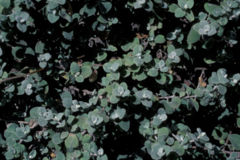Xeranthemum
| subsp. var. | ||||||||||||||||||||||||||||||||||||||||||||||||||||||||
|---|---|---|---|---|---|---|---|---|---|---|---|---|---|---|---|---|---|---|---|---|---|---|---|---|---|---|---|---|---|---|---|---|---|---|---|---|---|---|---|---|---|---|---|---|---|---|---|---|---|---|---|---|---|---|---|---|

|
|
| ||||||||||||||||||||||||||||||||||||||||||||||||||||||
| ||||||||||||||||||||||||||||||||||||||||||||||||||||||||
| Standard Cyclopedia of Horticulture |
|---|
|
Xeranthemum (Greek, dry flower: it is one of the "everlastings"). Compositae. Annual erect herbs, densely pubescent or tomentose, of which X. annuum is one of the oldest and best known of the "everlastings" or immortelles. Heads rayless, but the large involucral scales are petal-like and persistent, giving the plant its value as a subject for dry bouquets: outer fls. few and sterile, inner ones fertile; receptacle chaffy; involucral scales in many series, of various lengths, glabrous; heads solitary on long naked peduncles.—Four or 5 species, Medit. region. The culture of xeranthemum is very simple. Seeds are usually sown in the open, where the plants are to stand; but they may be started outdoors and the seedlings transplanted. Hardy or half-hardy annuals.
|
Xeranthemum {{{latin_name}}}
|
'
| ||||||||||||||||||||||||||||||||||||||||
|---|---|---|---|---|---|---|---|---|---|---|---|---|---|---|---|---|---|---|---|---|---|---|---|---|---|---|---|---|---|---|---|---|---|---|---|---|---|---|---|---|---|

|
|
| |||||||||||||||||||||||||||||||||||||||
| |||||||||||||||||||||||||||||||||||||||||
Many-branched plants. Up to 2 inch long silvery leaves are be oblong to lanceolate. The papery flowers are dry, shiny and can be either single or double. Flowers reach as much as 2 in. wides and come in white, rose, or pink. Make good drying flowers. Cut flowers when buds are starting to open, or they turn a light brown.
Cultivation
| calendar? | ||
|---|---|---|
| January: | ||
| February: | ||
| March: | ||
| April: | ||
| May: | ||
| June: | ||
| July: | ||
| August: | ||
| September: | ||
| October: | ||
| November: | ||
| December: | ||
| Notes: | ||
- Do you have cultivation info on this plant? Edit this section!
Can be grown in well-drained soil that is anywhere from moist to a bit dry. Plants are drought tolerant, and should get sun at least half of the day.
Propagation
- Do you have propagation info on this plant? Edit this section!
From seed.
Pests and diseases
- Do you have pest and disease info on this plant? Edit this section!
Species
Gallery
If you have a photo of this plant, please upload it! Plus, there may be other photos available for you to add.
-
photo 1
-
photo 2
-
photo 3
References
External links
- w:Xeranthemum. Some of the material on this page may be from Wikipedia, under the Creative Commons license.
- Xeranthemum QR Code (Size 50, 100, 200, 500)
